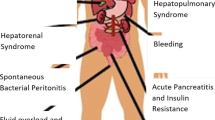Abstract
Ascites and particularly encephalopathy in the setting of chronic liver disease are traditionally thought to be poor prognostic markers of end stage liver disease. Diagnostic and therapeutic approaches to these complications are based on experience with adult patients, however, differences in the spectrum of aetiologies causing end stage liver disease together with the relative resistance of the pediatric patient to encephalopathy impact on the management of such patients. The following is a review of current thinking in the aetiology and management of ascites and encephalopathy in the setting of chronic liver disease in children.
Similar content being viewed by others
References
Morali GA, Snideramn KW, Deitel KMet al. Is sinusoidal portal hypertension a necessary factor for the development of hepatic ascites?J Hepatol 11992; 16 : 249–250.
Garcia-Tsao G. Current management of the complications of cirrhosis and portal hypertension: variceal hemorrhage, ascites and spontaneous bacterial peritonitis.Gastroenterology 2001; 120: 726–748.
Rossle M, Ochs A, Golberg Vet al. A comparison of paracentesis and transjugular intrahepatic portosystemic shunting in patients with ascites.N Engl J Med 2000; 342: 1701–1707.
Garcia-Tsao G. Treatment of refractory ascites: tips or taps?Hepatology 2001; 33: 477–479.
Heyman MB, LaBerge JM. Role of transjugular intrahepatic portosystemic shunt in the treatment of portal hypertension in pediatric patients.J Ped Gastro Nutr 1999; 29: 240–249.
Rimola A, Garcia-Tsao G, Navasa M, Piddock V, Planas R, Bernard Bet al. Diagnosis, treatment and prophylaxis of spontaneous bacterial peritonitis: a consensus document.J Hepatol 2000; 32: 142–153.
Gines P, Rimola A, Planas R, Vargas V, Marco F, Almale M. Norfloxacin prevents spontaneous bacterial peritonitis recurrence in cirrhosis: results of a double-blind, placebo-controlled trial.Hepatology 1990; 12: 716–724.
Jones EA. Pathogenesis of hepatic encephalopathy.Clinics in Liver Dis 2000; 4: 467–485.
Albrecht J, Dolinska M. Glutamine as a pathogenic factor in hepatic encephalopathy.J Neuroscience Res 2001; 65: 1–5.
Sand P., Kawadias D, Feineis Det al. Naturally occurring benzodiazepines:current status of research and clinical implications.Eur Arch Psych Clin Neuroscience 2000; 250: 194–202.
Watanabe A. Cerebral changes in hepatic encephalopathy.J Gastroenterol Hepatol 1998; 13: 752–760.
Weber Fl Jr. Lactulose and combination therapy of hepatic encephalopathy: the role of intestinal microflora.Dig Dis 1996 14: 53–63.
Scevola D, Zarmelli A, Concia Eet al. Non-absorbable disaccharides plus neomycin in hepatic encephalopathy: do they enhance each other?La Clinica Terapeutica 1989; 129: 105–111.
Marchesini G, Bianchi G, Rossi B, Brizi M, Melchionda N. Nutritional treatment with branched-chain amino-acids in advanced liver cirrhosis.J Gastroenterol 2000; 35: 7–12.
Charlton CPJ, Buchanan E, Holden CEet al. Intensive enteral feeding in advanced cirrhosis: reversal of malnutrition without precipitation of hepatic encephalopathy.Arch Dis Child 1992; 67: 603–607.
D’Amico G, Morabito A, Pagliaro Let al. Survival and prognostic indicators in compensated and decompensated cirrhosis.Dig Dis Sci 1986; 31: 468–475.
Matalack J, Shaid D, Urback Aet al. Choosing a pediatric recipient for orthotopic liver transplantation.J Pediatr 1987; 111: 479–489.
Wayman KI, Cox KL, Esquivel CO Neuro-developmental outcome of young children with extrahepatic biliary atresia 1 year after liver transplantation.J Pediatr 1997; 131: 894–894.
Bhaduri RR, Mieli-Vergani G. Fulminant hepatic failure: Pediatric aspects. SeminLiver Dis 1996; 16: 349–355.
Hartmann U, Groeneweg M, Quero JCet al. The prognostic significance of subclinical hepatic encephalopathy.Am J Gastro 2000; 95: 2029–2034.
Kamath PS, Wiesner RH, Malinchoc Met al. A model to predict survival in patients with end-stage liver disease.Hepatology 2001; 33: 464–470.
Gitlin N. Hepatic encephalopathy. In Zakim D, Boyer M, eds.Hepatology: A Textbook of Liver Disease. 3rd edn. Philadelphia: W.B. Saunders, 1996; 12: 605–617.
Author information
Authors and Affiliations
Corresponding author
Rights and permissions
About this article
Cite this article
Hardikar, W. Ascites and encephalopathy in chronic liver disease. Indian J Pediatr 69, 169–173 (2002). https://doi.org/10.1007/BF02859379
Issue Date:
DOI: https://doi.org/10.1007/BF02859379




